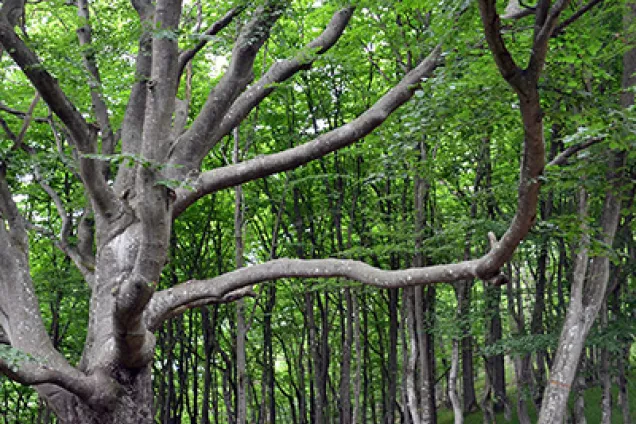Research
Division of Building Materials
Research areas
Our society is founded on huge amounts of concrete. The annual global cement production is 4 billion tons (more than twice that of steel and aluminium production combined) and this is used to make 25 billion tons of concrete, but it also generates about 7% of the global CO2 emissions. To reduce this significant CO2 footprint, the traditional Portland cement is today increasingly replaced by a diverse array of industrial by-products, natural materials, and novel binders. This results in significant challenges for concrete manufacturers as the new binders change durability-related properties of the concrete, such as pore size distributions.
Mortar and concrete laboratory
Building materials LTH has a laboratory for production and testing of mortars and concrete. This is used for teaching, research and industrial development work. Most of our work in the concrete field has been concerned with durability issues (frost, chlorides, carbonation) and drying. Our mortar and concrete laboratory are well equipped with standard equipment for mixing, compacting, strength tests etc, we also have:
- Climate chambers and climate rooms for exposure studies.
- Freezers for frost testing.
- An array of equipment for measurements of moisture sorption and transport properties.
- Several pieces of equipment for dynamic E-modulus measurement.
- Methods for studies of drying and self-desiccation of concrete.
- A range of isothermal calorimeters for hydration studies.
- Equipment for non-isothermal frost calorimetry.
- Bespoke devices for long-term creep studies.
Laboratory for low carbon binders
To complement our work on concrete drying and concrete durability, we are now also focusing on experimental techniques to study novel binders and mortars/concretes made with such materials. This can be both binder combinations with high (40-90%) SCM replacement ratios and non-Portland binders such as calcium-sulfoaluminate and supersulfated cements. We do most of our work in collaboration with industry, for example by testing SCM:s with the R3-method and making sulfate optimization on blended cements.
Our laboratory is well equipped for binder studies. For initial study of binders and SCM:s, we have a laboratory mill, laser diffractometer particle sizer, calorimeters for hydration studies (including R3-tests), instruments for non-destructive measurement of E-modulus as a convenient method for the study of the development of mechanical properties. Our instrumentation is complemented by equipment at other departments on the LTH campus, for example XRD at Center for Analysis and Synthesis, SEM and ESEM at several departments, and micro-tomography at Division of Solid Mechanics. We are also close to the large-scale facilities MAXIV (synchrotron light source) and ESS (neutron source).
Contact person: Lars Wadsö
Already from the start of Building Materials LTH some 60 years ago we have had a focus on moisture. The reason is simple: almost all degradation phenomena are dependent on moisture. Three examples are concrete carbonation, wood degradation and steel corrosion. In most cases increased moisture levels cause problems, but in some cases – like concrete carbonation – the correlation is more complex.
At Building Materials LTH, we both measure moisture properties of materials, determine moisture states of materials, and expose materials to different moisture programs:
- We have several techniques for determining sorption isotherms, from boxes with RH-control by saturated salt solutions to six automated sorption balances (DVS). We also have a unique custom built pressure plate lab for determination of over-hygrocopic sorption isotherms and conditioning at water potential close to saturation.
- We have cup method set-ups to determine transport coefficients.
- Many of our studies – especially for cement-based materials – are made with capacitive RH-sensors and we have a two-pressure instrument for the calibration of such sensors. We have also used resistance measurements in studies of wood components.
- We have both climate chambers and climate rooms where we can expose small and large samples to different temperatures and relative humidities.
Contact person: Peter Johansson
The durability of construction materials is an important field, as the life-cycle cost and environmental impact of a building is influenced by how long materials last before repair, replacement or demolition. Building Materials LTH have over the years worked with durability issues of many different types of materials, for example concrete (frost, chloride, carbonation), wood, sealants, brick facades and rendering, floor screeds and flooring adhesives.
Frost degradation mechanisms of concrete have been the subject of several PhD-projects, some of which used different types of sorption calorimeters to study freezing and thawing from a thermodynamic perspective. Also, chloride transport and carbonation have been studied. Contact person: Peter Johansson
A more recent activity is the field of wood durability, which is very much related to the moisture state of the material. Research here involves the relations between physicochemical properties of wood materials – both natural and modified – and their resistance to fungal attack.
Contact person: Maria Fredriksson
Multiphysics modeling is a computational approach that simulates multiple physical phenomena and their interactions within a single system. By solving coupled equations, it predicts real-world behavior more accurately than separate, single-physics analyses. Our work specializes in moisture-related processes in aging materials, particularly concrete and other cement-based systems. These materials undergo complex interactions—such as moisture transport, heat transfer, and mechanical stress—that strongly influence durability and long-term performance. Capturing these coupled effects enables us to make better design decisions, reduce the need for physical prototypes, accelerate development, and improve the reliability and lifespan of concrete structures.
Contact person: Magnus Åhs

Our international network
in Lund University's Research Portal
Power Bio - an Interreg Project
Division of Building Materials participates in the Power Bio project funded by Interreg Øresund-Kattegat-Skagerrak, Region of Sjælland and project partners.

LTH Profile Area: Circular Building Sector
The Division participates in LTH's profile area Circular Building Sector, which is an important part of the transition to carbon neutrality and a sustainable society - on lth.se.
Research Portal
Research projects
The following links will open in Lund University's Research Portal:
